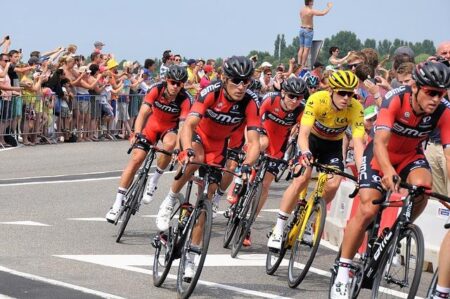Guidelines Introduced to Mitigate Drafting Impact in Women’s Races of the Life Time Grand Prix Series
In a significant move to enhance the integrity of competition in women’s cycling, the Life Time Grand Prix series has announced new guidelines aimed at eliminating the “huge impact” of drafting in women’s races. Drafting, a common tactic that allows cyclists to ride closely behind one another to reduce wind resistance, can create disparities in performance and race dynamics, particularly in fields with varying levels of experience. The introduction of these guidelines, which seek to establish clearer regulations and promote fair play, comes in response to growing concerns from athletes and stakeholders about the implications of drafting on race outcomes and the overall competitive landscape. As the series prepares for its next season, this initiative underscores a commitment to fostering an equitable environment for all competitors, ensuring that race results reflect genuine athletic effort and skill.
Guidelines for Fair Competition in Women’s Cycling Events
As the Life Time Grand Prix series gears up, new guidelines aim to mitigate the significant impact of drafting in women’s cycling events. These regulations are intended to level the playing field, fostering competitive integrity and encouraging individual performance. Key measures include:
- Increased spacing between competitors: A mandatory distance will be enforced to reduce the advantages gained through drafting.
- Monitoring and enforcement: Course marshals will be stationed throughout events to ensure adherence to the new rules.
- Education programs: Riders will participate in sessions that highlight the importance of fair play and the implications of drafting.
In addition to these measures, feedback from participants will be solicited to refine the guidelines continually. A focus on transparency and accountability is paramount, ensuring all competitors understand the rules and the consequences of violations. The following table outlines potential penalties for infractions:
| Infraction | First Offense | Second Offense | Third Offense |
|---|---|---|---|
| Drafting Violation | Warning | 5-Minute Time Penalty | Disqualification |
| Failure to Comply with Spacing | Warning | 10-Minute Time Penalty | Disqualification |
Strategies to Mitigate Drafting Advantages in Grand Prix Races
To balance competitive dynamics in Grand Prix races, it’s essential to implement strategies that minimize the advantages gained from drafting. Race organizers can introduce measures such as increasing the distance between race segments, ensuring that the rest periods are long enough to discourage advantageous drafting practices. Additionally, altering race formats can foster more dynamic racing, promoting mixed tactics where riders cannot solely rely on their drafting partners. These innovations could include individual time trials within the race, allowing for a fairer assessment of each athlete’s performance across varied racing conditions.
Moreover, introducing distinct windbreak zones could be an effective way to limit the drafting advantage. This could involve sections of the course specifically designed to challenge riders’ tactics and engage solo efforts. The regulations should include strict penalties for excessive reliance on drafting, encouraging a more tactical and diverse racing strategy. To aid in this effort, race officials can create a transparent point system or leaderboard that emphasizes independent performance, fostering an environment that celebrates individual achievements alongside team dynamics. These combined approaches will be pivotal in maintaining the integrity of the competition and ensuring a level playing field for all participants.
Implementing Effective Rules for Enhanced Clarity and Safety
In an effort to enhance both clarity and safety within women’s racing, the Life Time Grand Prix series is set to implement a series of effective rules aimed at minimizing the detrimental effects of drafting. The changes aim to ensure a more equitable racing environment, where athletes can compete on a level playing field. Key adjustments will include:
- Drafting zones will be clearly marked, limiting where riders can benefit from the aerodynamic advantage.
- Time penalties for infractions will be enforced, deterring intentional violations of the new drafting policies.
- Education sessions will be held prior to races, informing participants about the updated rules and safety protocols.
Additionally, the series will introduce a new communication system to enhance race management. This will involve:
| Feature | Description |
|---|---|
| Real-time updates | Riders will receive instant notifications about race conditions and rule enforcement via their selected devices. |
| Race marshals | More marshals will be stationed throughout the course to monitor drafting violations closely. |
These strategies are expected to not only improve race integrity but also enhance the overall experience for athletes and fans alike, reinforcing the commitment to safety and fairness in women’s cycling competitions.
The Way Forward
As the Life Time Grand Prix series prepares to implement new guidelines aimed at mitigating the significant impact of drafting in women’s races, the cycling community is poised for a transformative shift. These measures reflect a growing recognition of the need for equitable racing conditions and the enhancement of competitive integrity in women’s events. With the introduction of these regulations, the focus will now be on promoting individual performance and fair play within the field, a development that could serve as a model for future competitions. As the cycling world watches closely, all eyes will be on how these guidelines influence race dynamics and athlete experiences in upcoming seasons. The ongoing dialogue around fairness and inclusivity in women’s cycling is more vital than ever, setting the stage for a new era in the sport.











